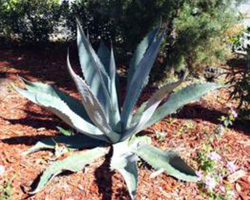Agave americana - Century plant



Family Agavaceae
Description:
Approximately 150 species of Agave are found in the Americas. This plant of Mexican highlands has succulent, evergreen, blue-gray leaves and is well-suited to a hot, dry environment. Leaves may reach 7 feet in length. Leaves have spines along the margins and a sharp spine at the tips. Despite the common name of century plant, these plants can mature and flower in about twenty to thirty years. Flower spikes may reach 30 feet in height. Bats, birds and insects are pollinators for the various species of agave. Individual plants die after flowering. In many species, the original plant forms a clump of plants before flowering and dying. In others, the original plant is survived by its seeds or plantlets that develop on the old flower spikes. In Mexico the heart of this species (the vegetative bud) and the developing flower spikes have been used as food. Seed has been ground into a flour. Sap from the cut flower stalk can be used as a syrup or fermented into pulque or mescal. Tequila is derived from the mashed stems of another species of century plant. The sap has been used medically.
Location:
Plants can be seen at UNF on the west side of the Fine Arts Building.
Size:
A large herbaceous plant with foliage to six feet tall and a flower spike to thirty feet or more.
Care Instructions:
Light: full sun to part shade
Water: very drought tolerant once established, does not survive in wet sites
Soil: well-drained, low fertility, wide pH tolerance, no other special requirements
The century plant will thrive in a sunny spot with a well-drained soil. It is a big, striking, sculptural specimen or accent plant that is easy to grow and very drought tolerant. Negatives include the sharp, sturdy spines at the leaf tips and the tendency for this plant to produce a large clump of spiny, young plants. (Suckers may be removed and planted in another site.)
